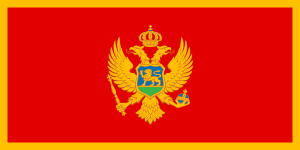Montenegro

Montenegro (Crna Gora or Црна Гораis in Montenegrin) is a small country in south eastern Europe. It shares borders with Albania, Croatia, Bosnia and Herzegovina, Kosovo and Serbia. The capital city is Podgorica. Other important cities are Nikšić, Budva and Bar. Montenegro is Europe's newest country after Kosovo. Montenegro isn't part of the European Union but it has applied to join in the future and it uses the Euro as its currency.
Montenegro's History
[edit | edit source]
Montenegro's independence from the Ottoman Empire was formally recognized in 1878. From 1918, Montenegro became a part of Yugoslavia. Based on the results of the referendum held on May 21, 2006, Montenegro declared independence on June 3, 2006 and is still currently the newest fully recognized country in the world. On June 28, 2006, it became the 192nd member state of the United Nations, and on May 11, 2007, the 47th member state of the Council of Europe.
Montenegro's Geography
[edit | edit source]Montenegro is a country located in South-eastern Europe. It covers a total area of 14,026 km2. It has a coast on the Adriatic Sea to the south and borders Croatia to the west, Bosnia and Herzegovina to the north-west, Serbia to the north-east, and Albania to the south-east. Its capital and largest city is Podgorica. The name Montenegro means "Black Mountain" and originates from the Venetian language. The country's name in Montenegrin is Crna Gora which has the same meaning as the English name. The highest mountain in Montenegro is Bobotov Kuk at 2,522m.


Montenegro's People
[edit | edit source]Montenegro has a population of around 620,000. Most of the population speak Montenegrin which is a dialect of Serbian, but other languages spoken include Albanian, Bosnian and Croatian. Most Montenegrin are Orthodox Christians. Other religions include Islam and Roman Catholicism.
Montenegrin children start their education in either pre-schools or elementary schools. Children begin at elementary schools at the age of 6; and continue for 9 years. The students may continue their secondary education, which lasts 4 years (3 years for trade schools) and ends with graduation. Higher education lasts with a certain first degree after 3 to 6 years.
Montenegro's Sights
[edit | edit source]Montenegro is very popular with tourists from western, central and southern Europe as well as Russia. Tourists visit the coastal areas for the night-life (in Budva) and the culture (in Kotor and Ulcinj). During the winter months there are ski resorts in the north of the country and bird watching is popular at Lake Skadar, the biggest lake in south-east Europe, because birds use the area as a stopping place during migrations.
Montenegro has two UNESCO World Heritage Sites: Kotor (small town at the end of a large fjord) and Durmitor National Park.
| Wikijunior Europe • Intro • EU • Geo • People • Language • Facts • Quiz | edit | ||
